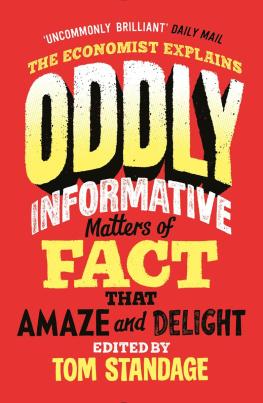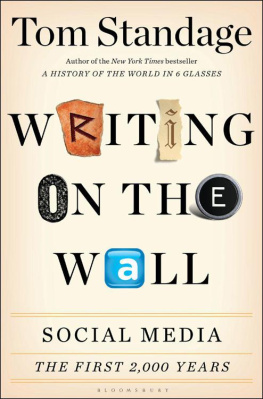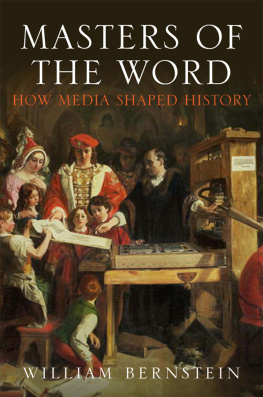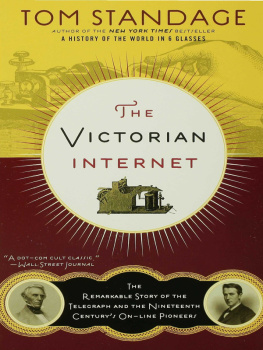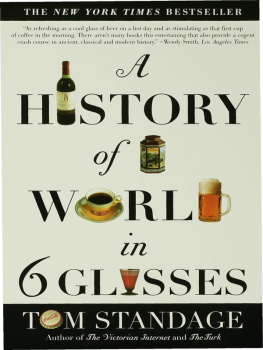An Edible History of Humanity
A History of the World in 6 Glasses
The Turk
The Neptune File
The Victorian Internet

Copyright 2013 by Tom Standage
All rights reserved.
No part of this book may be used or reproduced in any manner whatsoever without written permission from the publisher except in the case of brief quotations embodied in critical articles or reviews. For information address Bloomsbury USA, 1385 Broadway, New York, NY 10018.
Published by Bloomsbury USA, New York
Library of Congress Cataloging-in-Publication Data has been applied for.
eISBN: 978-1-6204-0284-9
First U.S. edition 2013
Electronic edition published in October 2013
To find out more about our authors and their books please visit www.bloomsbury.com where you will find extracts, author interviews and details of forthcoming events, and to be the first to hear about latest releases and special offers, sign up for our newsletters here.
For Miles
Contents
Not to know what has been transacted in former times is to be always a child. If no use is made of the labors of past ages, the world must remain always in the infancy of knowledge.
Marcus Tullius Cicero
In July 51 B.C. the Roman statesman and orator Marcus Tullius Cicero arrived in Cilicia, in what is now southeast Turkey, to take up the post of proconsul, or regional governor. Cicero had been deeply reluctant to leave the bustle of Rome, where he was a central figure in the plotting and counterplotting of Roman politics, and he intended to return as soon as was decently possible. The burning question of the day was whether Julius Caesar, commander of Romes armies in the west, would make a grab for power by marching on the city. Cicero had spent his career trying to defend the political system of the Roman republic, with its careful division of powers and strict limits on the authority of any individual, from Caesar and others who wished to centralize power and seize it for themselves. But a new anticorruption law required Cicero and other trustworthy elder statesmen to take up posts as provincial governors. Fortunately, even in distant Cilicia, Cicero had the means to stay in touch with the goings-on in Romebecause the Roman elite had developed an elaborate system to distribute information.
At the time there were no printing presses and no paper. Instead, information circulated through the exchange of letters and other documents which were copied, commented on, and shared with others in the form of papyrus rolls. Ciceros own correspondence, one of the best-preserved collections of letters from the period, shows that he exchanged letters constantly with his friends elsewhere, keeping them up to date with the latest political machinations, passing on items of interest from others, and providing his own commentary and opinions. Letters were often copied, shared, and quoted in other letters. Some letters were addressed to several people and were written to be read aloud, or to be posted in public for general consumption.
When Cicero or another politician made a noteworthy speech, he could distribute it by making copies available to his close associates, who would read it and pass it on to others. Many more people might then read the speech than had heard it being delivered. Books circulated in a similar way, as sets of papyrus rolls passed from person to person. Anyone who wished to retain a copy of a speech or book would have it transcribed by scribes before passing it on. Copies also circulated of the acta diurna (the daily acts, or state gazette), the original of which was posted on a board in the Forum in Rome each day and contained summaries of political debates, proposals for new laws, announcements of births and deaths, the dates of public holidays, and other official information. As he departed for Cilicia, Cicero asked his friend and protg Marcus Caelius Rufus to send him copies of each days gazette along with his letters. But this would be just part of Ciceros information supply. Others will write, many will bring me news, much too will reach me even in the way of rumor, Cicero wrote.
With information flitting from one correspondent to another, this informal system enabled information to penetrate to the farthest provinces within a few weeks at most. News from Rome took around five weeks to reach Britain in the west and seven weeks to reach Syria in the east. Merchants, soldiers, and officials in distant parts would circulate information from the heart of the republic within their own social circles, sharing extracts from letters, speeches, or the state gazette with their friends and passing news and rumors from the frontier back to their contacts in Rome. There was no formal postal service, so letters had to be carried by messengers or given to friends, traders, or travelers heading in the right direction. The result was that Cicero, along with other members of the Roman elite, was kept informed by a web of contactsthe members of his social circleall of whom gathered, filtered, and distributed information for each other.
To modern eyes this all seems strangely familiar. Cicero was, to use todays Internet jargon, participating in a social media system: that is, an environment in which information was passed from one person to another along social connections, to create a distributed discussion or community. The Romans did it with papyrus rolls and messengers; today hundreds of millions of people do the same things rather more quickly and easily using Facebook, Twitter, blogs, and other Internet tools. The technologies involved are very different, but these two forms of social media, separated by two millennia, share many of the same underlying structures and dynamics: they are two-way, conversational environments in which information passes horizontally from one person to another along social networks, rather than being delivered vertically from an impersonal central source.
Ciceros web is just one of many historical antecedents of todays social media. Other notable examples include the circulation of letters and other documents in the early Christian church; the torrent of printed tracts that circulated in sixteenth-century Germany at the start of the Reformation; the exchange and copying of gossip-laden poetry in the Tudor and Stuart courts; the dueling political pamphlets with which Royalists and Parliamentarians courted public opinion during the English Civil War; the stream of news sheets and pamphlets that coursed through Enlightenment coffee houses; the first scientific journals and correspondence societies, which enabled far-flung scientists to discuss and build upon each others work; the pamphlets and local papers that rallied support for American independence; and the handwritten poems and newsletters of prerevolutionary France, which spread gossip from Paris throughout the country. Such social-media systems arose frequently because, for most of human history, social networks were the dominant means by which new ideas and information spread, in either spoken or written form. Over the centuries, the power, reach, and inclusivity of these social-media systems steadily increased.
But then, starting in the mid-nineteenth century, everything changed. The advent of the steam-powered printing press, followed in the twentieth century by radio and television, made possible what we now call mass media. These new technologies of mass dissemination could supply information directly to large numbers of people with unprecedented speed and efficiency, but their high cost meant that control of the flow of information became concentrated in the hands of a select few. The delivery of information assumed a one-way, centralized, broadcast pattern that overshadowed the tradition of two-way, conversational, and social distribution that had come before. Vast media empires grew up around these mass-media technologies, which also fostered a sense of national identity and allowed autocratic governments to spread propaganda more easily than ever before.


